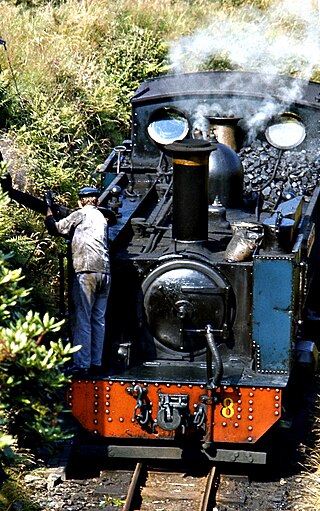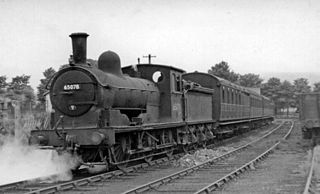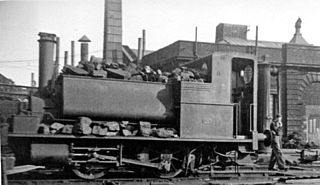The London, Midland and Scottish Railway had the largest stock of steam locomotives of any of the 'Big Four' Grouping, i.e. pre-Nationalisation railway companies in the UK. Despite early troubles arising from factions within the new company, the LMS went on to build some very successful designs; many lasted until the end of steam traction on British Railways in 1968. For an explanation of numbering and classification, see British Rail locomotive and multiple unit numbering and classification.

The steam locomotives of British Railways were used by British Railways over the period 1948–1968. The vast majority of these were inherited from its four constituent companies, the "Big Four".
A number of different numbering and classification schemes were used for locomotives and multiple units operated by British Railways (BR), and this page explains the principal systems. This section also covers the post-privatisation period, as the broad numbering and classification arrangements have not altered since the break-up of BR.
The London and North Eastern Railway (LNER) produced several classes of locomotive, mostly to the designs of Nigel Gresley, characterised by a three-cylinder layout with a parallel boiler and round-topped firebox. It produced the most famous locomotive of its day, 4468 'Mallard', the holder of the world steam locomotive speed record. It also built the world-famous 4472 'Flying Scotsman'. However, its locomotive inheritance was much greater than just the 'A4 Class', it also produced highly successful mixed-traffic and freight designs.

The British Rail Class 98 is a Total Operations Processing System (TOPS) classification that has been used to cover all steam locomotives used on the mainline in Britain, but also has a particular usage for the three Vale of Rheidol Railway-design 2-6-2T locomotives that remained in the ownership of British Rail (BR) after the end of mainline steam traction in August 1968. The locomotives on the Vale of Rheidol Railway were the only steam locomotives ever officially to carry the British Rail corporate blue and the double arrow logo.
Although prototype diesel locomotives ran in Britain before World War II, the railways of both the Republic and Northern Ireland changed over much more rapidly from steam to diesel traction than those in Britain, due to the island's limited coal reserves and an ageing steam locomotive fleet.

The North Eastern Railway (NER) Class C1, was a class of 0-6-0 freight locomotives designed by T.W. Worsdell. They were used throughout the NER system, although particularly in Teesside between 1886 and 1962.

The Great Central Railway (GCR) Class 9F was a class of 0-6-2T steam locomotive built between 1891 and 1901. From 1923 the locomotives were redesignated Class N5.
British Rail Class D3/14 was a diesel-electric locomotive built by the London and North Eastern Railway at its Doncaster Works. It had a Petter engine, and Brush Traction electricals. It was absorbed by British Railways on nationalisation, but was withdrawn in the pre-TOPS era.
A number of different numbering and classification schemes were used for the locomotives owned by the London and North Eastern Railway (LNER) and its constituent companies. This page explains the principal systems that were used. The following abbreviations for the constituent companies are used on this page:

Under the Whyte notation for the classification of steam locomotives, 0-8-4 represents the wheel arrangement of no leading wheels, eight powered and coupled driving wheels on four axles, and four trailing wheels on two axles.

Neville Hill is a railway train maintenance depot in Osmondthorpe, Leeds, England on the Leeds to Selby Line. The depot is situated 2 miles 14 chains (3.5 km) to the east of Leeds railway station on the north side of the line.

The LNER Class Y1 was a class of 0-4-0 geared steam locomotives built by Sentinel Waggon Works for the London and North Eastern Railway and introduced in 1925. They passed into British Railways ownership in 1948 and were numbered 68130-68153 but 68134 was withdrawn almost immediately and may not have carried its BR number.

The GER Class 209 was a class of 0-4-0 saddle tank steam locomotives of the Great Eastern Railway. These locomotives were similar to the NBR G Class but had flat-topped, instead of round-topped, tanks. A total of eight were built – four by Neilson and Company in 1874 and four more by the GER's Stratford Works between 1897 and 1903.
The London and North Eastern Railway (LNER) operated various classes steam locomotives with a 4-6-2 wheel arrangement. The LNER operated more pacifics than any other of the Big Four British railway companies, and they were mostly used for express passenger work along the East Coast Main Line, though later in their lives many were displaced to other lines.
There were a number of engine sheds and railway works located in York. The large York North engine shed became the National Railway Museum in 1975.

The GER Class B74 was a class of five 0-4-0T steam locomotives designed by Alfred John Hill for the Great Eastern Railway. They all passed to the London and North Eastern Railway at the 1923 grouping and received the LNER classification Y4.

The GER Class G69 was a class of twenty 2-4-2T steam locomotives built by for the Great Eastern Railway by S. D. Holden in 1911–12 following the design of two rebuilt examples of the GER Class M15 designed by James Holden, his father, in 1904. They all passed to the London and North Eastern Railway at the 1923 grouping and received the classification F6.

The GER Class M15 was a class of 160 2-4-2T steam locomotives designed by Thomas William Worsdell and built for the Great Eastern Railway between 1884 and 1909. The original (F4) class of locomotives were fitted with Joy valve gear which was notoriously difficult to 'set'. This earned them the nickname of 'Gobblers' thanks to their high coal consumption rates. As a result, between 1911 and 1920, 32 of them were rebuilt by James Holden with Stephenson valve gear and higher pressure boilers. Despite this, the nickname stuck for many years after.